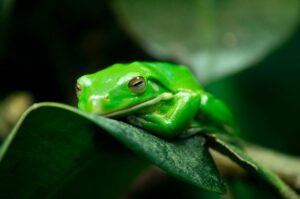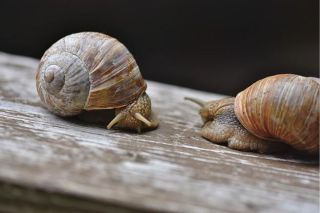How Do Frogs Protect Themselves?(10 Defensive Behaviors You Didn’t Know Exist)
What happens when you try to catch a frog? It hops and gets away, right? If you are like most people, you may probably think that’s how frogs react every time they sense danger. But, as you will soon discover today, that is not always the case.
How do frogs protect themselves?
There are different methods frogs use to protect themselves when faced with danger or predators. Most frogs normally camouflage to stay out of sight, while others will try to flee. Some might play dead, which is quite clever since most predators don’t like feeding on carcasses. Also, some might produce toxic chemicals to warn predators or poison them.
In the next section, we will look at over ten mechanisms frogs use to defend themselves.

Frog Defense Mechanism
So what exactly is a defense mechanism? Well, it can mean a lot of things, but for the purpose of this article, we will define it in relation to nature. In that regard, a defense mechanism is simply a strategy or technique an organism uses to protect itself from danger. Danger can include predators or conditions in the environment.
In the case of frogs, their defense mechanism helps protect them from larger animals or predators and survive the winter cold.
Frogs rarely fight back when they face predators, which is understandable considering their small and weak nature.
As earlier indicated, different frogs have different defences or ways of keeping themselves alive. These include both absurd and nasty methods. We will go over them in the next section.
How do frogs protect themselves from predators?
Frogs do not have many defense mechanisms like some animals. There are about 10 of them we know about. Let’s go over each one.
Breaking Toe Bones into Claws
Some frogs usually break their own bones to use as weapons to deter predators. This is probably one of the most insane things you will hear about frogs.
It happens with a Central Africa Frog species, also known as the “horror frog” or, more commonly, hairy frog. The frog actually breaks down its toenails, then pushes them through its skin, so they come out looking like claws. It does this whenever it feels threatened by potential attackers.
Interestingly, this happens to be the only way (from what we know) the hairy frog use to defend itself against predators.
We are not sure what happens subsequently when the predator goes away, but scientists are of the opinion that as the muscle relaxes, the claws revert back into the skin.
Using Coloration
Some frogs may also employ coloration as a survival tactic against a predator.
Different frogs use different types of coloration, but all of them accomplish the same thing – to protect the frog or deter a predator.
There are 3 major types of coloration:
Protective Coloration (Camouflage)
Here, the frog changes its skin colour to match that of its environment, and this helps it to remain undetected or hidden from predators. The squirrel tree frog and glass frog are two good examples of frog species that use camouflage or protective coloration.
Flash Coloration
Frogs that use flash coloration only use it when they feel threatened by an enemy.
In other words, the trait remains hidden and doesn’t show until there’s an imminent threat. When this happens, the frog lights up (like a flash) to confound the predator and escapes in the process.
A species of treefrog known as Agalychnis callidryas or red-eyed tree frog flashes its red eyes whenever it’s under attack by what could be a predator. The Malaysian leapfrog will also startle potential enemies with its bright colors.
Aposematic Coloration
Here, frogs use bright colors to confound or warn predators that they taste bad or are poisonous. This is done by secreting toxic liquids from their skin. The toxins usually cover their body, and most times, this will be enough to deter predators. But for stubborn predators who choose not to stay away, the experience from the damage done will teach them to avoid such frogs the next time they see them.
Three good examples of frogs with this type of defence are the poison dart frog, monkey frog, and poison arrow frog.
Secreting Poison
As earlier indicated in aposematic coloration, there are many species of frogs with poison glands that secrete toxic chemicals to scare off potential attackers.
The poison dart frog is very notorious for this type of behaviour. Sometimes, the poison it releases is strong enough to either paralyze a predator or kill it completely. It is worth noting toxicity varies among poison frogs as there are over a hundred species in the Amazon alone. Some species are very toxic, while some are just a little toxic.
Many natives in Central and South America commonly use the poison from these frogs on the tip of their blow darts and hunting arrows. That is probably where they get their name – poison dart frog – from.
Screaming
Screaming is another means some frogs use to deter predators. They have a weird loud scream which they use to scare away enemies. Whether the frog is picked up by the predator or it sights the predator from a distance, it will scream out loud to startle the predator. When this happens, the predator will drop the frog or try to get away.
Swimming/Hopping
Frogs are naturally good swimmers, which is not surprising since some parts of their lives are spent in water. Some use this as a method of adaptation when confronted with danger. They quickly look for the nearest water body and dive to the bottom to get away or hide from an enemy.
This is a common response when the frog is attacked by an animal that cannot swim. It will remain at the water base until it no longer senses danger.
The same thing happens when the frog is attacked in water. It will quickly hop onto land to get away from the predator.
So much for being an amphibian, right?
Feigning Death
Some frogs may also pretend to be dead when caught by a predator. In this case, they drop and remain still and stop breathing, all in a bid to discourage the enemy from eating them.
The frogs don’t have to be captured to pull off this trick; in fact, most of the time, they respond this way when they perceive a predator is close by.
Two good examples of frogs that do this really well are the leopard frog and American bullfrog.
The leopard frog holds its breath and stays motionless when spotted or captured, while the bullfrog often goes completely limp.
Using Scary False Eyes
Certain species of frogs like the eupemphix nattereri (or false-eyed frog) have “false” eyes on their back or hind end, which they use to scare away intruders. These are not actual real eyes but large spots that look like the eyes of a larger animal.
They show off these two eyes spots when under attack so that when the predator sees them, it becomes afraid and probably retracts its step.
Sometimes, the frog will also release a foul-smelling liquid from the two false eyes to dissuade predators from eating them. This is commonly the case when the eye spots alone do not scare away the predator.
Bluffing
Bluffing is another trick some species of frogs use to defend themselves.
Here, the frog fills its lung with air to force the enlargement of its neck, sometimes up to the point its body is raised off the ground. So, it appears larger and too big for predators to swallow.
This type of defence is commonly used against snakes and similar animals that might attempt to swallow the frog.
The African bullfrog is a typical example of a frog with this type of defense mechanism. When under attack, the frog will puff up by lunging in the direction of the attacker with its mouth open. It then inflates itself up to a point it becomes too large to swallow.
Urination
Some frogs may empty the content of their bladder as they jump away. The foul odor from the urine helps to cover their scent and give them a bad taste.
Rolling Away
Another defensive behaviour you may encounter among frogs is rolling away. Some frogs will fold themselves into a ball and roll away from what they perceive as a threat. A good example is the pebble frog from Venezuela. It will stop when it feels threatened, tuck its legs beneath its body, and simply roll away like a ball. The color of the frog makes it look like a frog, which is why it’s called the pebble frog.
Jumping
Many frogs will simply jump away to escape a predator. And sometimes, they will cover considerable distances in the process.
How do frogs survive the winter?
Frogs such as the common rain frog and wood frog are able to survive the winter through “hibernation.” They do this by creating their own natural antifreeze to prevent being frozen to death.
The wood frog basically makes its brain and heart inactive. To accomplish this feat, it pumps a lot of glucose into the tissues to cut down the number of ice crystals formed within the cells. This prevents the cells from getting burst from so much ice. In other words, the excess glucose acts as natural antifreeze.
Rain frogs also apply the same technique during food scarcity in the dry season. During this time, the frog produces mucous cocoons to stop its body from losing water while buried in its burrow. It usually comes out of hibernation around September/October, when there’s a high food supply, especially termites. Coincidentally, this is also the period rain starts, when the frogs breed.
Frog Body Parts Used For Protection
There are specific body parts used by different frog species for protection. Let’s look at the most obvious ones.
Bulging Eyes
Some frogs have bulging eyes that allow them to get a panoramic view of the environment. This makes it easier to evade the enemy.
NOTE: By panoramic, we mean the ability to see in all directions.
Sticky Hairs
The majority of rainforest frogs are great tree climbers. And that is mainly because they have sticky hair pads or patches on various areas in their body, such as their toes, fingers and belly. They can climb high trees to escape predators.
Skin Pores
Virtually every frog has poison glands in its skin. However, in some, the toxins are not potent enough to pose any serious threat to predators.
Poison dart frogs are known to secret fatal toxins from their skin pores. However, toxicity is usually associated with color brightness. In other words, the brighter the colour, the more toxic the poison. The golden dart frog is believed to be the most toxic, having enough venom to kill 10-20 people.
Strong Legs
Some frog species, such as tree frogs and ground frogs, have very strong legs that allow them to escape predators. In fact, tree frogs can jump from treetops and glide to safety.

What is the best way for a frog to protect itself from possible danger
So, how does a frog defend itself when in danger?
The best way frogs protect themselves from danger is by staying hidden, either through camouflage or by taking cover underground (or under some kind of object).
What if camouflage doesn’t work; what does the frog do?
Some of them may pretend to be dead by remaining motionless. A lot of predators don’t like dead prey.
How do poisonous frogs not poison themselves?
It’s believed that the dart frog carries a toxin two hundred times stronger than morphine. While this is destructive for predators and can kill a human, it doesn’t seem to affect the frog.
So, how is this possible?
A recent study attributes this to genetic changes. Somehow, the frog’s nervous system has evolved over time to fend off the effect of these toxins.
It is worth noting that poison frogs don’t produce the toxins on their own but derive them from consuming ants and mites. These smaller animals contain some toxic materials that are recycled by the frog when they eat them.
What animals are frogs afraid of? (10 Natural predators of a frog)
Frogs have a lot of animals that consume them. These mainly include carnivorous animals, as well as mammals. Below are some examples:
- Birds
- Bats
- Raccoons
- Fish
- Reptiles
- Heron
- Snakes
- Turtles
- And even humans
In fact, humans go as far as destroying their natural habitat, which affects their breeding activities.
Do any frogs bite to defend themselves?
Most frogs don’t bite to protect themselves. However, some species behave differently, especially in the face of an imminent attack. Two good examples are the horned tree frogs and African bullfrogs. Both frog species are large and have wider mouths that they normally use to devour their prey. They will also bite hard on predators to protect themselves when the need arises.
Specifically, the horned tree frogs from South America have fangs on their lower jaws, which are made up of bones. They will often open their mouths wide at enemies and may bite if engaged.
Conclusion: How Do Frogs Protect Themselves?
While frogs look like they fall behind when it comes to size and strength, they are not always an easy prey for predators. They also have ways of protecting themselves in different environments.
The frog defence mechanism discussed here are the more common ones. If you feel there’s any other important one we left out, let us know.
More Resources
https://stoneageman.com/how-a-poison-dart-frog-kills-you/





